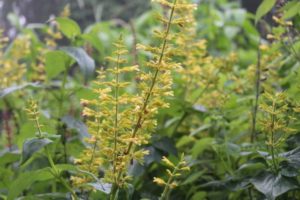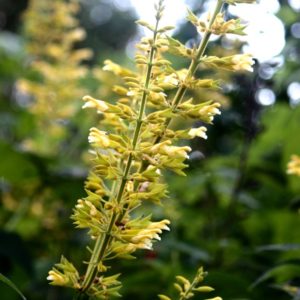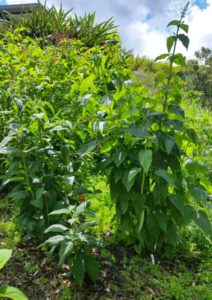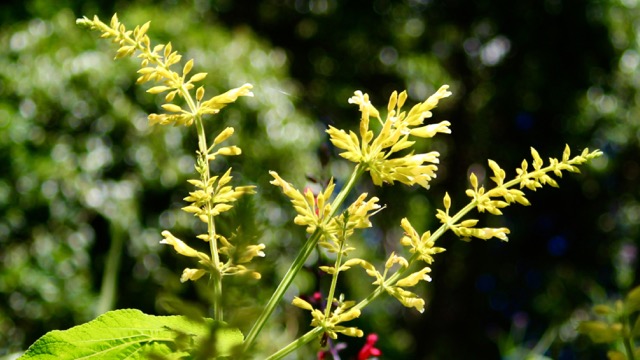Salvia madrensis is remarkable among the sages for having yellow flowers. This makes it particularly desirable for anyone with a salvia collection. It is called forsythia sage in the Northern Hemisphere, less so here where Forsythia is rarely seen.

In favourable conditions madrensis is a big plant. It sends up strong canes from the base that can reach well over 2 metres high. Canes are basically square in cross-section but tend to have prominent ridges in each corner, which probably help with strength. They remind me of medieval castle keeps in cross section. The leaves are also big, up to 30 cm long on 10 cm petioles, broadly heart shaped, and densely covered with fine hairs. Betsy Clebsch states that it comes from high altitude parts of the Sierra Madre Oriental in Mexico.

Flowers
The yellow flowers of Salvia madrensis are borne on long spikes, up to 80 cm. Spikes are held upright at the ends of the canes, well clear of the leaves, and often branch near the base. Flowers form in clusters at 3-5 cm nodes along the spikes, giving a stepped or bottlebrush effect. Each node is actually a pair of flower clusters on opposite sides of the stem, and each cluster has up to 15 flower buds. The spike stems and calyces are pale green, but are covered in yellow hairs, which extends the yellow effect beyond the petals. The official flowering period is through the cooler months; here from May to September. Mine routinely flower right through Summer, too, possibly in response to Spring drought.

Cultivation
S. madrensis is a plant for warm climates. It is frost tender and it flowers in Midwinter, so it can be a challenge to grow satisfactorily in cold climates. It likes well drained soil that stays moist, particularly over Summer, although it tolerates dry Winter conditions. I grow mine in afternoon shade and have yet to test it in sunnier conditions, but I doubt the large leaves would appreciate full sun in this climate. Madrensis is renowned for very fast growth in warm weather.
Madrensis would overshadow most bushy salvias. It needs a few metres to spread into and it grows well with other large caney salvias like confertiflora, gesneriiflora, adenophora, karwinskii, large involucratas and wagneriana.
Propagation
Salvia madrensis sets seed which germinates readily enough. The seedlings grow quickly. Otherwise it grows from cuttings, although you need to get the timing right for these, as the stems tend to be either too sappy and soft when they are fast-growing, or otherwise hollow and too large. A useful and fast method with established plants is to cut suckers from the base.
As a curiosity, the fine hairs on the leaves, stems and flowers are glandular and sticky, and often catch small insects like flypaper.

